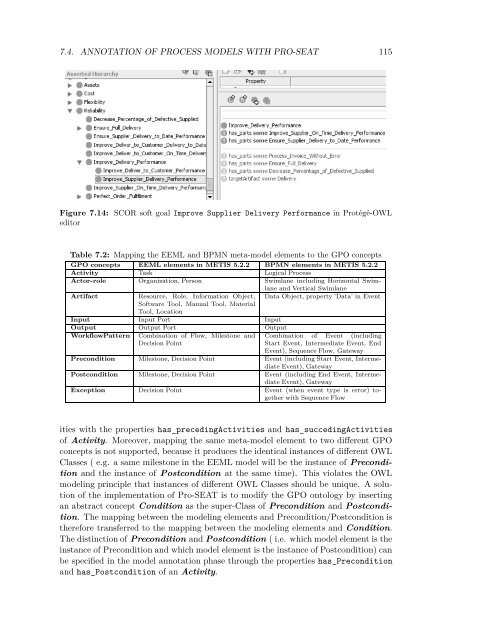Semantic Annotation for Process Models: - Department of Computer ...
Semantic Annotation for Process Models: - Department of Computer ...
Semantic Annotation for Process Models: - Department of Computer ...
You also want an ePaper? Increase the reach of your titles
YUMPU automatically turns print PDFs into web optimized ePapers that Google loves.
7.4. ANNOTATION OF PROCESS MODELS WITH PRO-SEAT 115<br />
Figure 7.14: SCOR s<strong>of</strong>t goal Improve Supplier Delivery Per<strong>for</strong>mance in Protégé-OWL<br />
editor<br />
Table 7.2: Mapping the EEML and BPMN meta-model elements to the GPO concepts<br />
GPO concepts EEML elements in METIS 5.2.2 BPMN elements in METIS 5.2.2<br />
Activity Task Logical <strong>Process</strong><br />
Actor-role Organization, Person Swimlane including Horizontal Swimlane<br />
and Vertical Swimlane<br />
Artifact<br />
Resource, Role, In<strong>for</strong>mation Object, Data Object, property ’Data’ in Event<br />
S<strong>of</strong>tware Tool, Manual Tool, Material<br />
Tool, Location<br />
Input Input Port Input<br />
Output Output Port Output<br />
WorkflowPattern<br />
Combination <strong>of</strong> Flow, Milestone and<br />
Decision Point<br />
Combination <strong>of</strong> Event (including<br />
Start Event, Intermediate Event, End<br />
Event), Sequence Flow, Gateway<br />
Precondition Milestone, Decision Point Event (including Start Event, Intermediate<br />
Event), Gateway<br />
Postcondition Milestone, Decision Point Event (including End Event, Intermediate<br />
Event), Gateway<br />
Exception Decision Point Event (when event type is error) together<br />
with Sequence Flow<br />
ities with the properties has_precedingActivities and has_succedingActivities<br />
<strong>of</strong> Activity. Moreover, mapping the same meta-model element to two different GPO<br />
concepts is not supported, because it produces the identical instances <strong>of</strong> different OWL<br />
Classes ( e.g. a same milestone in the EEML model will be the instance <strong>of</strong> Precondition<br />
and the instance <strong>of</strong> Postcondition at the same time). This violates the OWL<br />
modeling principle that instances <strong>of</strong> different OWL Classes should be unique. A solution<br />
<strong>of</strong> the implementation <strong>of</strong> Pro-SEAT is to modify the GPO ontology by inserting<br />
an abstract concept Condition as the super-Class <strong>of</strong> Precondition and Postcondition.<br />
The mapping between the modeling elements and Precondition/Postcondition is<br />
there<strong>for</strong>e transferred to the mapping between the modeling elements and Condition.<br />
The distinction <strong>of</strong> Precondition and Postcondition ( i.e. which model element is the<br />
instance <strong>of</strong> Precondition and which model element is the instance <strong>of</strong> Postcondition) can<br />
be specified in the model annotation phase through the properties has_Precondition<br />
and has_Postcondition <strong>of</strong> an Activity.
















